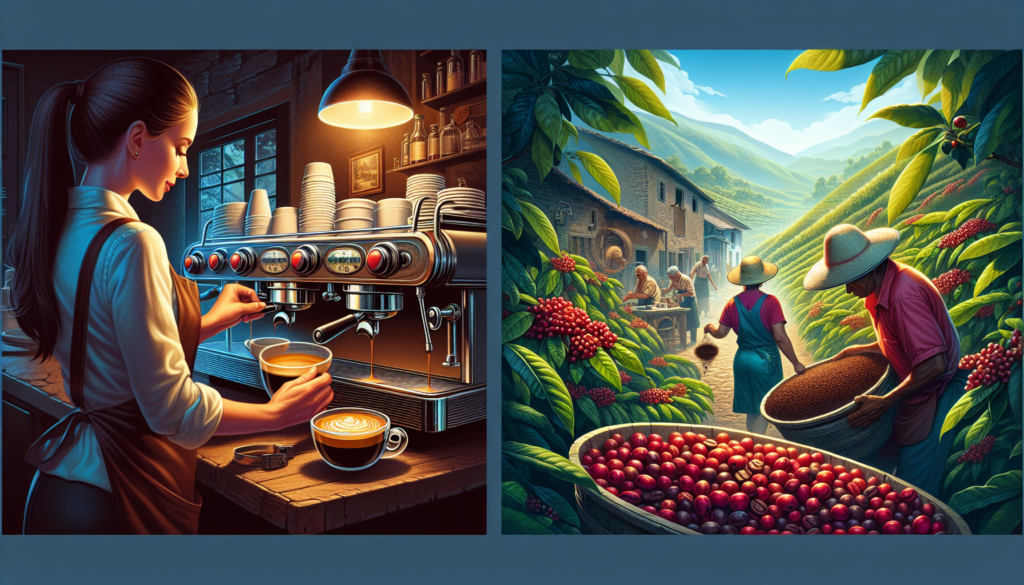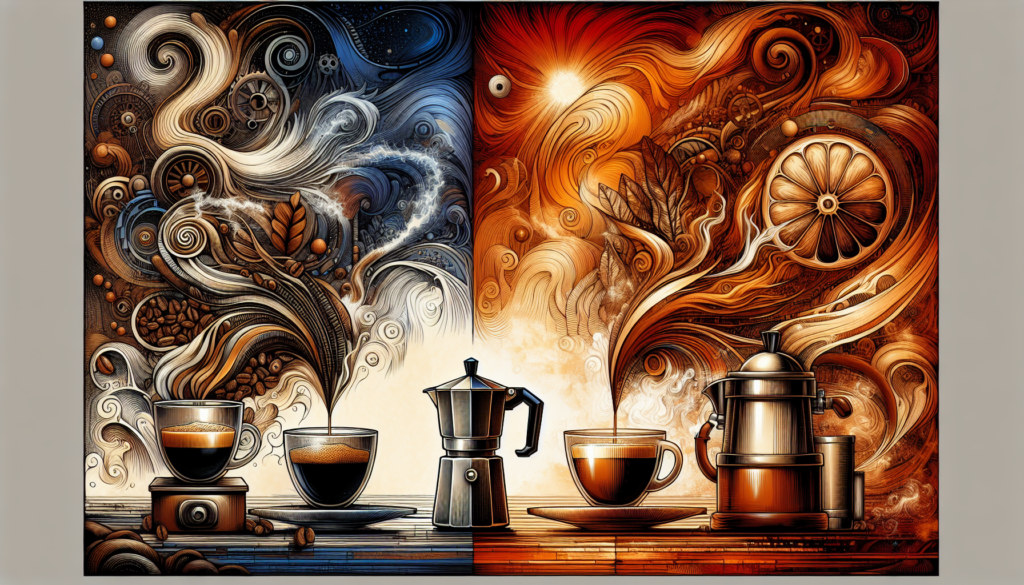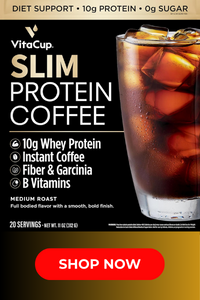So you’ve heard of espresso and coffee, but do you ever wonder how they are actually different? Well, let’s break it down for you. Espresso is a concentrated form of coffee made by forcing hot water through finely ground coffee beans. The result? A strong and full-bodied brew, with a rich aroma and a layer of crema on top. On the other hand, regular coffee is made by steeping coarser coffee grounds in hot water, resulting in a milder and less intense flavor. So, next time you’re at a café and debating between espresso and coffee, you’ll know exactly what sets them apart.
Roasting Process
Light roast
When it comes to the roasting process of coffee beans, the level of roast significantly impacts the flavor and aroma of the final beverage. Light roast coffee beans are roasted for a relatively shorter period, resulting in a light-brown color. This roast brings out the natural flavors and characteristics of the coffee beans, preserving their delicate and nuanced profiles. Light roast coffee tends to have a higher acidity level, a lighter body, and often tastes more vibrant and fruity.
Medium roast
Moving on to the medium roast, these beans are roasted for a slightly longer duration, resulting in a medium-brown color. This roast strikes a balance between the original flavors of the coffee beans and the smoky notes developed during the roasting process. Medium roast coffee generally has a well-rounded flavor with a pleasant acidity and medium body. It tends to exhibit a slightly richer taste compared to light roast coffee while still offering a variety of flavor notes that can be enjoyed.
Dark roast
Lastly, we have the dark roast, typically roasted until the beans have a dark-brown or almost black appearance. Dark roast coffee beans have a bold and intense flavor profile, characterized by smoky, earthy, and roasted notes. These beans are roasted for a longer duration, resulting in a significant reduction in their natural acidity. Dark roasts also tend to have a fuller body and can often feature a bittersweet taste. While the unique flavors of the coffee beans may be somewhat overshadowed by the roasting process, dark roast coffee can be enjoyed by those who prefer a more robust and strong brew.
Grind Size
Fine grind
The grind size of coffee beans plays a crucial role in determining the brew’s taste and extraction process. A fine grind is typically used for espresso and certain brewing methods, such as Turkish coffee. This grind size allows for a higher surface area of the coffee particles to be exposed to water, resulting in a quicker extraction process. The end result is a concentrated and intense flavor profile, as well as a thicker and heavier body. The fine grind ensures that water can pass through the coffee grounds efficiently, producing a strong and bold cup of coffee.
Coarse grind
On the other hand, a coarse grind is commonly used for brewing methods such as French press and cold brew. The larger coffee particles in a coarse grind have a slower extraction process, allowing for a milder and smoother flavor profile. This grind size is ideal for methods where a longer brewing time is required, enabling a gentle extraction of the coffee’s flavors without extracting too much bitterness. The resulting brew is often characterized by a lighter body, with subtle and well-rounded flavor notes.

Brewing Method
Drip brewing
Drip brewing, also known as filter brewing, is one of the most popular methods for brewing coffee. It involves pouring hot water over a bed of coffee grounds placed in a filter. As the water drips through the grounds, it extracts the flavors and oils, which then flow into a pot or carafe beneath. This method is known for producing a clean and bright cup of coffee, with a medium body and balanced flavors. The drip brewing process allows for a controlled and consistent extraction, making it a go-to choice for many coffee enthusiasts.
French press
The French press, also known as a plunger pot or press pot, is a classic and beloved brewing method. It involves steeping coffee grounds in hot water for a few minutes and then pressing a plunger to separate the brewed coffee from the grounds. The French press method creates a rich and full-bodied brew, often with a slightly thicker texture and more pronounced flavors. This method allows for the coffee’s oils to be present in the final cup, contributing to a fuller and more aromatic experience.
Moka pot
The Moka pot, also referred to as a stovetop espresso maker, combines elements of both espresso and drip brewing methods. It consists of two chambers: one for water and one for coffee grounds. As the water in the lower chamber heats up, steam pressure forces the water through the coffee grounds and into the upper chamber. The Moka pot produces a strong and concentrated coffee, similar to an espresso, with a medium body and rich flavor. While not true espresso, it can be a suitable alternative for those who don’t have an espresso machine.
Beans Used
Arabica beans
Arabica beans are widely regarded as some of the best coffee beans in the world. They are known for their superior quality and exceptional flavor profiles. Arabica beans are grown at higher altitudes, which contributes to their complex flavors and well-balanced acidity. They often exhibit a wide range of flavor notes, including fruity, floral, and sometimes even chocolaty undertones. Arabica beans tend to have a smoother and more nuanced taste compared to Robusta beans, making them a popular choice among coffee enthusiasts.
Robusta beans
Robusta beans, as the name suggests, are known for their robust and bold flavors. They are typically grown at lower altitudes and are more resistant to diseases and pests compared to Arabica beans. Robusta beans have a higher caffeine content and tend to exhibit a stronger and sometimes bitter taste. They produce a thicker crema, the foamy layer on top of an espresso shot, and contribute to a fuller body in the final brew. While they may not offer the same complexity of flavors as Arabica beans, Robusta beans are often used in espresso blends to enhance the coffee’s strength and intensity.

Caffeine Content
Espresso
Espresso is known for its intense and concentrated flavor profile, but what about its caffeine content? Surprisingly, despite its robust taste, espresso actually contains less caffeine than a regular cup of coffee. This is because espresso is typically brewed using a smaller serving size and a higher coffee-to-water ratio. The average 1-ounce shot of espresso contains approximately 63 milligrams of caffeine, whereas an 8-ounce cup of coffee can contain anywhere between 95 to 165 milligrams of caffeine. So, if you’re looking for a bolder taste without a caffeine overload, espresso might be the answer.
Coffee
When we talk about coffee, we usually refer to the brewed beverage made from coffee grounds. The caffeine content in coffee can vary depending on various factors such as the type of coffee beans, the brewing method, and the serving size. On average, an 8-ounce cup of coffee contains around 95 milligrams of caffeine. However, it’s important to note that different coffee beans and brewing methods can result in varying caffeine levels. For example, Robusta beans have a higher caffeine content compared to Arabica beans, and espresso shots have a higher concentration of caffeine due to their smaller serving size.
Brewing Time
Espresso
Espresso brewing is a relatively quick process compared to other brewing methods. From the moment the water passes through the coffee grounds until the extraction is complete, it usually takes around 20 to 30 seconds. This short brewing time is achieved by the high pressure and temperature used in espresso machines. The quick extraction yields a concentrated and intense flavor profile. The resulting espresso shot is known for its bold taste and rich body, making it a favorite choice for those looking for a quick and strong caffeine boost.
Coffee
When it comes to brewing coffee, the duration can vary depending on the chosen brewing method. Drip brewing, for example, typically takes around 5 to 6 minutes to complete. French press brewing involves steeping the coffee grounds for 3 to 4 minutes before pressing the plunger. Cold brew, on the other hand, requires a longer brewing time ranging from 12 to 24 hours. These extended brewing times allow for a more gradual infusion of flavors, resulting in a smoother and less acidic cup of coffee.
Serving Size
Espresso
Espresso shots are typically served in small, demitasse-sized cups. The standard serving size for a single shot of espresso is around 1 ounce, while a double shot is around 2 ounces. The small serving size allows for the concentrated flavors and higher coffee-to-water ratio to be enjoyed in a single, strong sip. Espresso shots are often used as a base for various espresso-based beverages such as lattes, cappuccinos, and macchiatos.
Coffee
The serving size for coffee can vary greatly depending on personal preference and cultural norms. In most cases, a standard cup of coffee is around 8 ounces, but larger servings of 12 or 16 ounces are also common. Some coffee shops even offer “tall” or “grande” sizes, which can range from 12 to 20 ounces. The larger serving sizes of coffee allow for a longer and more leisurely drinking experience, perfect for enjoying a hot cup of joe throughout the day.
Taste Profile
Espresso
Espresso shots are known for their bold and intense flavor profiles. The concentrated extraction process, along with the high pressure and finer grind size, results in a rich and well-balanced taste. Espresso often exhibits strong and complex flavor notes, including chocolate, caramel, nuts, and even fruitiness. However, due to its stronger nature, the taste of espresso can sometimes be described as slightly bitter or sharp. The overall flavor experience of espresso largely depends on the quality of the coffee beans used, the roast level, and the brewing technique.
Coffee
Coffee brewed using various methods can offer a wide range of taste profiles, making it a versatile and beloved beverage. The flavors of coffee can be influenced by factors such as the type of coffee beans, the roast level, and the brewing method. Depending on these variables, coffee can have flavors ranging from fruity and floral to earthy and chocolatey. Light roast coffee often exhibits brighter and more vibrant flavor notes, while dark roast coffee tends to have bolder and smokier flavors. The taste profile of coffee can also be influenced by personal preferences and any added ingredients or flavorings.
Crema
Crema, the creamy and foamy layer that forms on top of an espresso shot, is an essential element of the espresso experience. It is created during the brewing process through the interaction of water, pressure, and carbon dioxide released from the coffee grounds. Crema adds a velvety texture to the espresso and serves as an indicator of a well-extracted shot. A rich and golden crema indicates freshness and proper extraction, while a thin or nonexistent crema can suggest issues with the espresso preparation or the quality of the coffee beans used.
Price
Coffee prices can vary depending on factors such as the type of coffee beans, the roast level, the origin, and the overall quality. Generally, more expensive or specialty coffee beans, such as single-origin or ethically sourced beans, command higher prices. The cost of coffee also depends on the brewing method and the location where it is purchased. Coffee served in specialty coffee shops or cafes tends to have a higher price compared to store-bought coffee beans or instant coffee. Ultimately, the price of coffee is influenced by various factors, but there are options available to suit different budgets and preferences.


